Zamioculcas: description, tips for growing
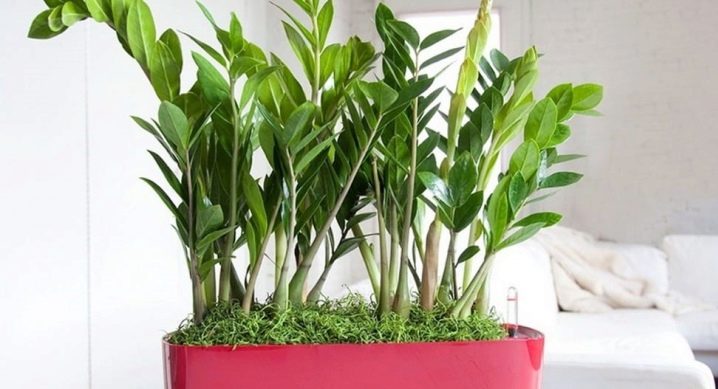
The attention of many is attracted by an evergreen plant, decorated with dark green leaves, called zamiokulkas. Only at the end of the 20th century, this plant began to be grown as an indoor plant. This plant is often referred to as the "dollar tree". According to legends, zamioculcas is a symbol of money, therefore it can be found in many institutions of large companies and banks. This noble flower looks beautiful and gorgeous. It is worth considering in more detail its features, varieties, subtleties of cultivation and reproduction.
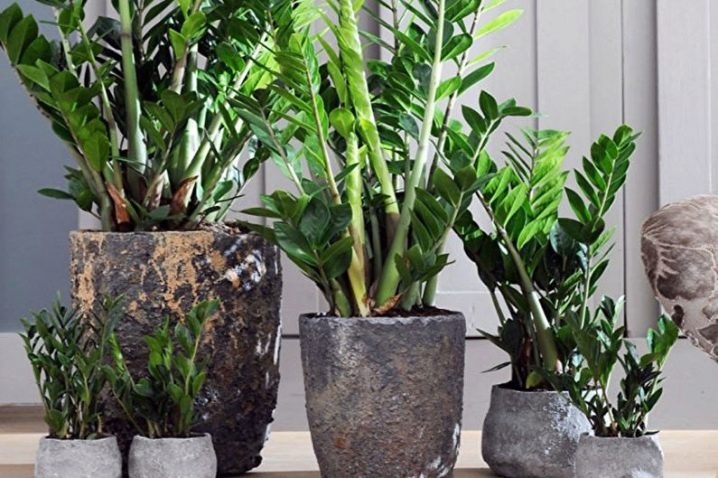
What it is?
Zamioculcas (Zamioculcas) is an evergreen plant that belongs to the aroid. But few know its name scientifically. The people use other names for this amazing flower - "eternal tree", "dollar palm", "flower of celibacy". But on the territory of Russia it is customary to call it the "dollar tree".
Zamioculcas is a succulent, therefore it grows in dry places with rather high temperatures. This plant perfectly tolerates both drought and heat. Only in the 90s of the XX century, this unusual plant was brought to the territory of Russia. It immediately attracted the attention of gardeners and was in great demand.
Zamikulkas can be found in houses and apartments, botanical gardens and greenhouses, and various administrative institutions.
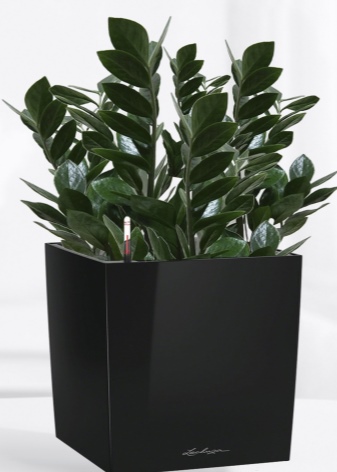
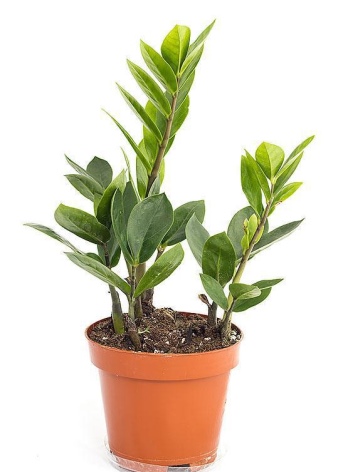
This flower looks quite noble and beautiful, while it does not need special care. This exotic plant costs a lot, but it is still in high demand among the residents of Russia. It is worth considering in more detail the description of zamiokulkas. Its uniqueness lies in the fact that it does not have a trunk, stems and branches, but only unusual leaves of a complex structure that grow immediately from the root system. It is presented in the form of a rather large underground tuber, from which rather thick roots extend, which outwardly resemble worms. The root system is an important element of the plant, because it absorbs moisture and is also responsible for maintaining it. Since the roots are quite strong, they can break the pot if it is too small for them.
The leaves of the plant have a glossy surface, complemented by a wax coating. They are erect, growing on thickened cuttings. The length of the leaves varies from 40 to 60 cm. The feathery leaves consist of 8–12 leaves, which are commonly called feathers. Rachis is the axis of the leaf, which is characterized by juiciness. Petioles, like rachis, have ink specks. The feathers of the plant are leathery and dense.
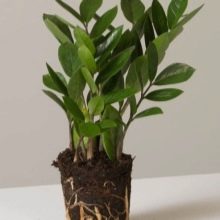
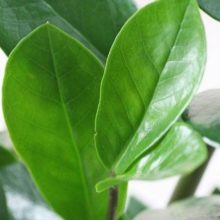

Interesting fact! Zamioculcas is often called zamielistny, because in appearance it is very similar to zamia - it is a rather rare gymnosperm flower, native to the tropics and subtropics of South and North America.
Zamioculcas is characterized by long growth. Within one year, only 2-3 new leaves appear, while the growth of existing leaves is from 10 to 15 cm. If you take good care of the plant, it can reach a meter length or even more. Usually, during drought, the plant sheds feathers, which helps prevent excess moisture evaporation. But the rachis and petioles remain on the tree.
To cope with long periods of drought, the plant is excellent at storing water in the tubers of the roots, as well as in the petioles and leaves.
On average, zamioculcas can grow from 5 to 10 years, so you should initially think about reproduction of this amazing plant. Zamioculcas blooms quite rarely, while only in maturity. The inflorescence of the plant outwardly resembles a thick ear, including small yellowish flowers, which are not particularly beautiful. The ear is usually found at the bottom of the plant, it appears on a thick, short peduncle. Since it is covered with a green petal, it is difficult to see it.
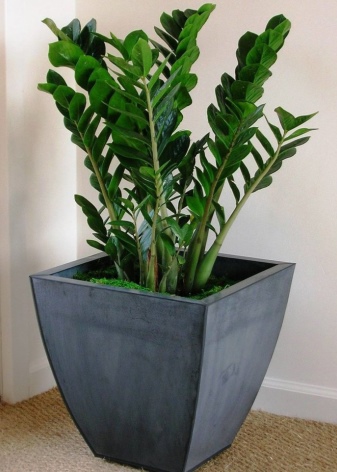
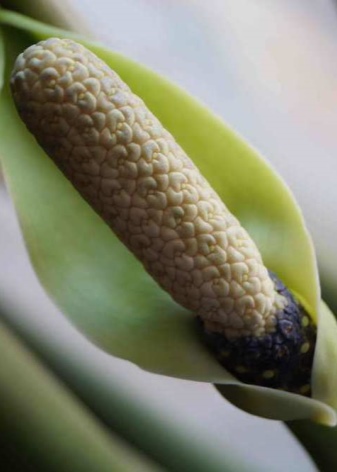
Zamioculcas begins to bloom only after reaching 3 years of age, while it needs ideal care conditions. Usually the plant blooms in spring, but there are exceptions when the ear appears already at the end of autumn, before the cold snap. The plant blooms for a long time, attracting others with an amazing and very beautiful aroma. But you need to know that even using artificial pollination, seed ovary does not occur. Therefore, flower growers recommend removing inflorescences at an early stage. An interesting fact is that usually flowering occurs already at the end of the plant's life.
It is worth noting that the tree sap is poisonous. Therefore, when caring for a flower, you should be careful. Always transplant, prune or propagate with special gloves. If the juice gets on the skin, eyes or mouth, a strong burning sensation may occur. But if you eat a leaf of a plant, then this can lead to allergic manifestations or gastrointestinal upset. Therefore, it is worth placing the plant away from children and animals. It should not be placed in the bedroom or in the kitchen, but rather “neutral” places.
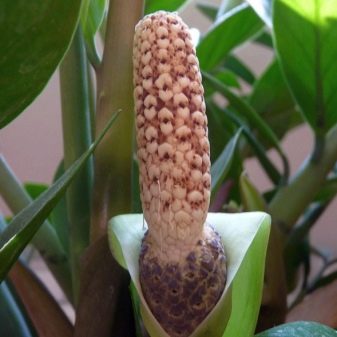

Varieties
The mountain plateaus in the south and southeast of Africa are home to Zamiokulkas. The plant was found only in 1828. A detailed description of this tropical plant is provided by renowned collector Konrad Loddijs. After 20 years, the name of this culture was changed to Zamiokulkas Loddijes. And already in 1908, this plant was recorded as a zamioculcas by the director of the large botanical garden in Berlin.
This plant has several varieties that are worth considering in more detail.
- Lanceolate... This is a natural variant of the plant. Its peculiarity lies in the fact that the leaves are lanceolate and longer than the usual zamioculcas.
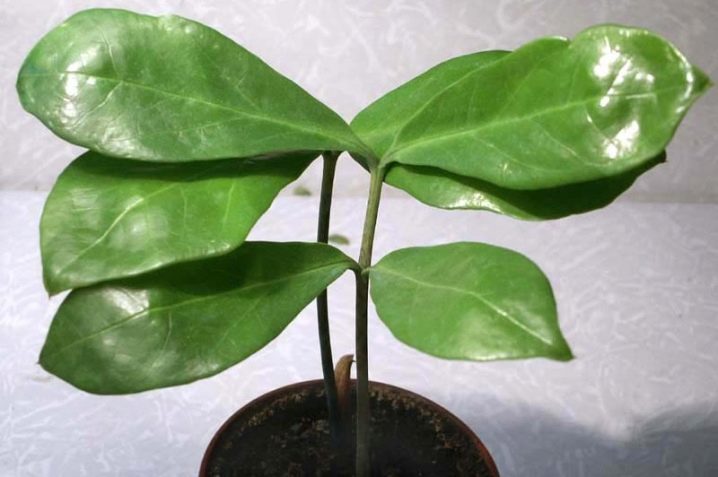
- Variegated... His homeland is Madagascar. This species is quite large, for example, it can reach a height and width of up to one and a half meters when grown at home. Its highlight is the color of the leaves, since the green plates are decorated with white stripes.
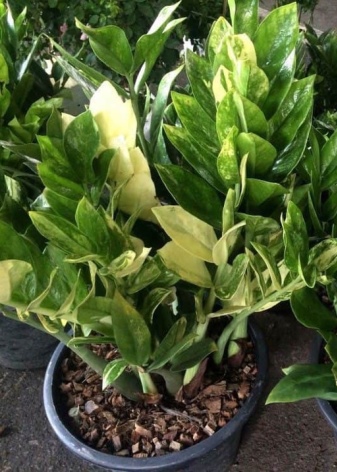
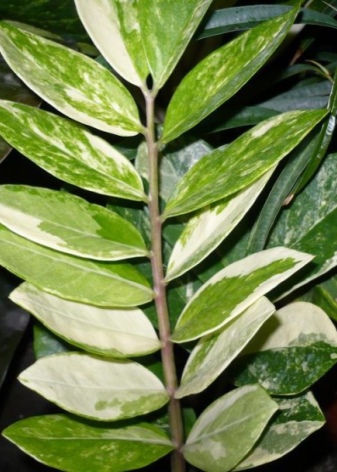
- Motley... Its differences are manifested not only in the form of sheet plates, but also in color. The leaves have elongated plates, supplemented with lemon spots.
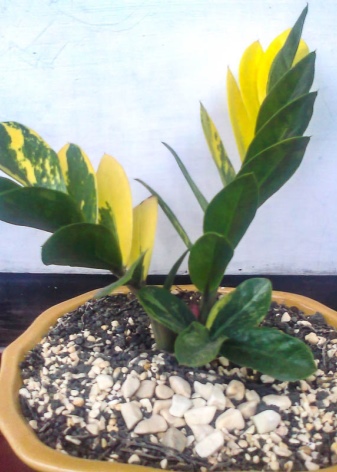
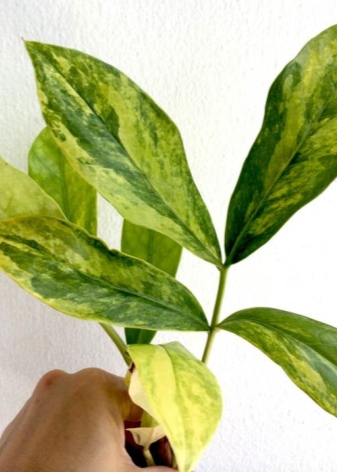
- Dark purple. His homeland is Korea. It can be safely called the smallest of all plant varieties. Young shoots are characterized by a light green color, which over time begins to darken until they are completely black.
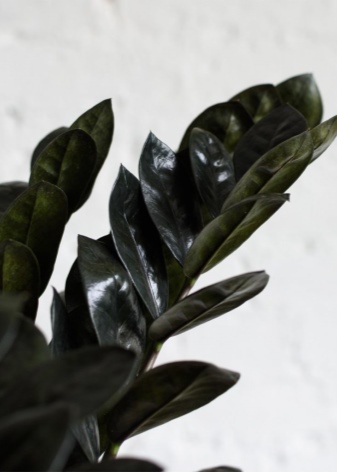

- Zamioculcas Boivin. Its peculiarity is a very large root tuber, which actively accumulates moisture. Unfortunately, this species cannot withstand dry air, so it needs regular spraying and watering. Emerald leathery leaves have smooth edges. Its flowering occurs quite rarely and for a short time. But it can be bred for beginners in floriculture, since it is unpretentious in care.
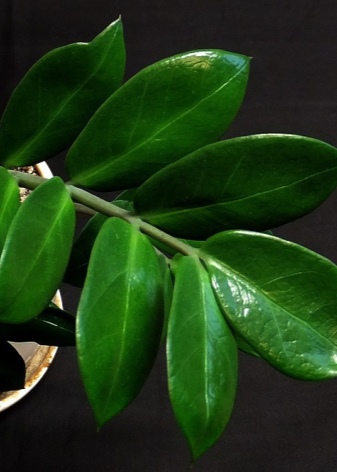
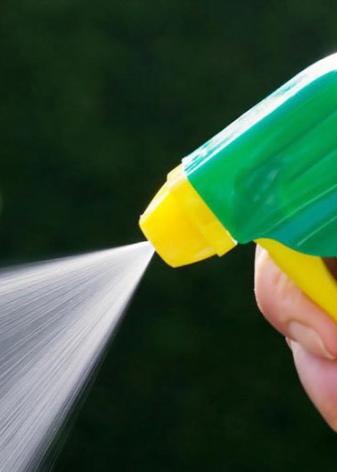
- Zenzi. This is another striking representative of dwarf plant varieties. It has a thickened trunk, dark green glossy leaves. Sometimes they even turn completely black. Plates are horizontal, while close to other plates.This variety attracts attention with its beauty.

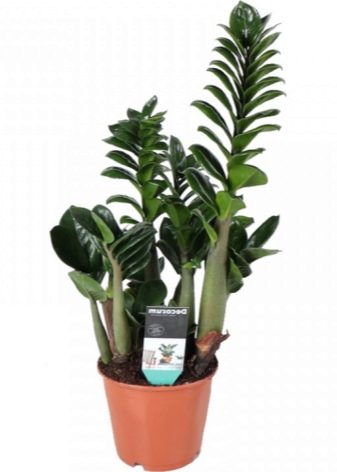
Some signs
Zamioculcas can be seen not only in residential premises, but also in office buildings. In feng shui, it has a very powerful energy, therefore it attracts wealth. Many people believe that having this amazing plant will make a lot of money. According to superstition, the plant should be located in the southeastern side of the room, because it is this zone that is responsible for wealth.
To increase the effect of the tree, it is necessary to put American coins in the soil of the pot.
It is worth noting that zamioculcas must be healthy and beautiful, otherwise it cannot be said that it helped to enrich itself. According to legends, if a new leaf appears on a plant, it is worth waiting for money, for example, you will be paid back your debts, given a bonus or hanging at work, and so on. If this plant is presented as a gift for any holiday, then its properties will become even stronger. If the "dollar tree" starts to hurt, which manifests itself in yellowing and falling leaves, you should be prepared for the fact that there will be additional costs, and it is also better to refrain from any financial transactions. A deterioration in the appearance of a flower can mean either financial problems or you are not taking good care of it.

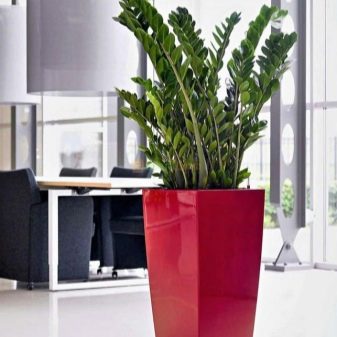
And here the flowering of zamiokulkas was a symbol of the fact that soon his mistress would definitely marry. Although this plant blooms very rarely, it still produces an unusual flowering. And this long wait for flowers led to another name for the plant - "flower of celibacy." If a girl has intentions to get married quickly, then it is better to refuse such a plant as a pet. Today there are quite a few legends that accompany zamiokulkas, and everyone has the right to independently decide whether to believe in them or not.

How to grow?
Zamioculcas does not require special care at home, since it is characterized by unpretentiousness. But when growing a "dollar tree" it is worth adhering to some basic rules. After acquiring a plant, he needs to be given time to get used to the new home, so for 2-3 weeks it should not be touched at all. It should be placed in partial shade, watered moderately, do not use top dressing and do not transplant.
If the habituation process goes well, then you can put the pot with the "dollar tree" in its permanent place.
Pot location
It is worth giving preference to the south or southeast side of the house. An excellent solution would be a windowsill or a place nearby. Due to its unpretentiousness, the plant can be placed even in a slight partial shade. It must be borne in mind that the zamioculcas, located on the north side, will have dull small leaves. If in winter the plant must be in the house, then in the summer it can be kept on a veranda or balcony, and some owners of a garden plot put it in the shade of trees.
An important advantage is that the "dollar tree" perfectly tolerates changes in location, small drafts and bright rays of the sun. It begins to grow quite quickly when it is located in the fresh air. Its root system is strengthened, so the plant is more resistant to various diseases and pests.
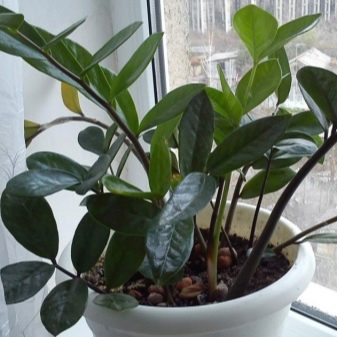
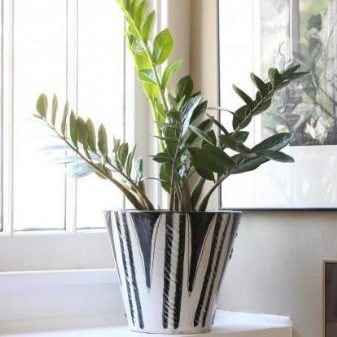
Temperature and lighting
An indoor plant feels great at an air temperature of +22 to +28 degrees in the summer and from +16 to +18 degrees in the winter. The highest temperature is +38 degrees, and the lowest is +12 degrees. The "dollar tree" is very fond of light, while it also feels normal when exposed to direct rays of the sun. Although partial shade is an excellent solution for him. But if you put the plant on the southern windowsill at noon, then its leaves may suffer, burns will appear, so it is better in this case to use improvised means to shade the plant.
If the zamiokulkas is kept in a dark room, then this will immediately affect its decorative effect. Its leaves will begin to thin and stretch. This plant needs fresh air, it cannot do without ventilation. To do this, it can be taken out to the balcony or garden in the summer. But in the cold season, it will be correct to place a pot with a plant near the windowsill, but you should avoid the close location of heating devices. In winter, when daylight hours are characterized by a short period, a fluorescent lamp or phytolamp should be used.
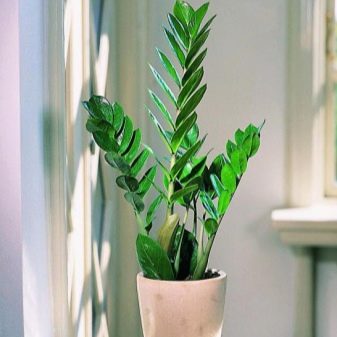
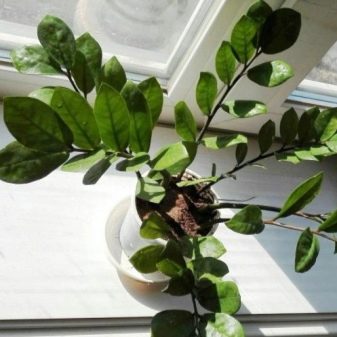
Watering
To properly care for the "dollar tree", you need to pay special attention to watering. The quality, like the quantity, of water plays an important role. The plant does not like excess moisture, water in the pan or high humidity in the room. Although you should not overdry the soil with roots either. Since during prolonged drought, the tree begins to use its internal reserve, while the upper leaf plates will begin to turn yellow and eventually fall off.
Wait before the next watering so that the soil is completely dry after the last watering. It is necessary to take exclusively settled water, or it can be boiled, and then cooled to room temperature before use. It is imperative that after watering, after a few minutes, you need to drain the water from the sump, because if you do not adhere to this rule, rotting of the root system is possible. If you do not have time to water, then you need a large pot, because then the plant will require less watering.
In the cold season, the plant needs less watering. So, it can be watered only 1-2 times a month.


Humidity
"Dollar tree" feels great in normal air humidity. If we compare dry and humid air, then, of course, dry is better for him, since he is used to the African deserts. Zamioculcas does not need to be sprayed. To clean the leaves of dust, it is necessary to wash under a warm shower, as an option, you can use a damp cloth for wiping. If, while airing in the garden, the plant falls under a slight rain, then this will not harm it.
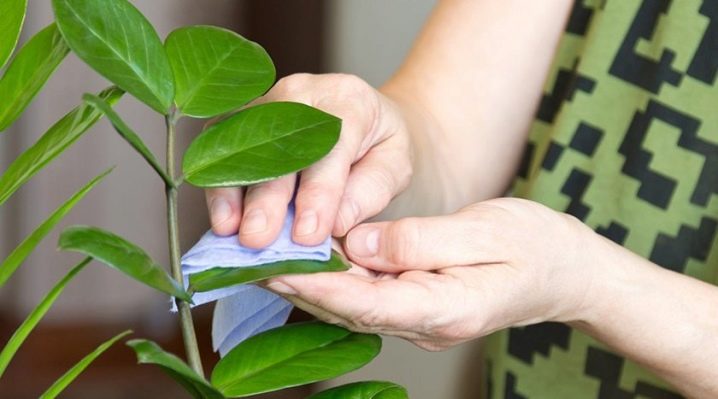
Top dressing
Zamioculcas very quickly draws out nutrients that are contained in the soil. This plant needs constant feeding during the active growth of leaves, which falls on the period from mid-spring to early autumn. You should use liquid fertilizers that are specifically designed for cacti or succulents. Some gardeners take universal fertilizers that are designed specifically for deciduous ornamental plants. But then you should definitely halve the dose than the manufacturer suggests. Such feeding is usually carried out 1-2 times a month. But in the autumn and winter periods, such feeding should be abandoned.
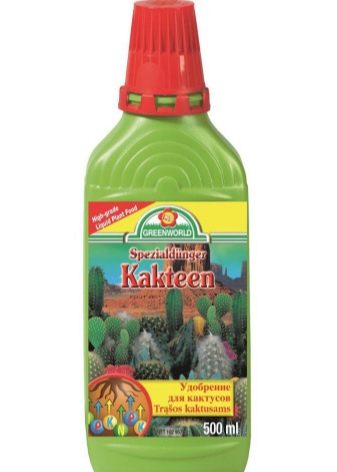

Priming
The plant is undemanding to the soil, although it is worth immediately abandoning heavy options. The soil should be chosen loose so that it perfectly passes both water and air. Its pH should be 6. For zamiokulkas, you can use both ready-made, purchase soil, and made by hand.
If you want to purchase soil for this flower, you should give preference to one that is designed specifically for ficuses, succulents and various deciduous ornamental plants.
For self-preparation of the earth, you need to take garden, sod and leafy soil in equal proportions, and then add 3 more parts of sand. The addition of a small amount of charcoal will be an excellent prevention of fungal infections. But in this case, you should be very careful, since a large amount of coal can lead to overdrying of the plant's root system.Further, it remains to calcine for 30 minutes in a preheated oven or put the soil in the freezer for 1 day, which will destroy both fungi and parasites.
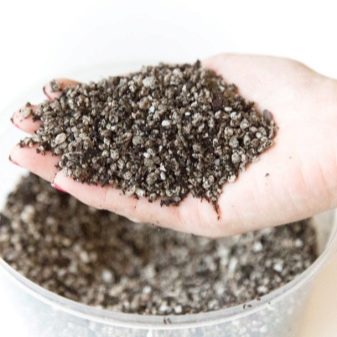
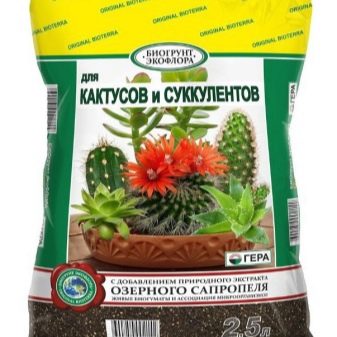
Transfer
The "dollar tree" is characterized by slow growth, so you can do without frequent transplants. If we consider young seedlings, then it is enough to transplant them 1 time in 2 years, but adult plants - 1 time in 5 years. If the tree has reached a large size, then there is no need to resort to transplanting, in this case it is enough just to change the topsoil.
In some cases, it is necessary to transplant the plant earlier.
- After the purchase. If the plant is taken from a local nursery, then the "hasty" transplant can be abandoned - to postpone it for 1-2 months. If the tree is on sale from another country, then transplantation is mandatory. Plants from abroad are usually brought in special soil, which is not suitable for the constant growth of the plant. Therefore, after 1 week, it is worth completely changing the substrate, while it is worth very carefully and thoroughly removing all the soil from the roots of the zamiokulkas. It is worth abandoning watering after planting, you need to wait a while so that all damage and wounds on the roots heal. Since the plant has a fairly large supply of moisture in the root system, this will be enough for it to grow and develop normally. After 2 weeks, you can start with spraying, while the water must be settled.
- The plant needs a transplant if its roots are already getting cramped in the containeras they begin to show on top of the substrate, as well as through the drainage holes in the pot. If the root system becomes cramped, then the tree slows down in growth.
- The poor appearance of the plant also requires an unscheduled transplant. In this case, the leaves usually become lethargic, then they begin to turn yellow and fall off. Root decay can be the reason for this situation. It is necessary to remove the old soil, clean the roots from the soil, and remove the rotten roots. After this, healthy roots should be rinsed in warm water with the addition of potassium permanganate, since it is responsible for disinfection. Then the roots need to be thoroughly dried and sprinkled with crushed coal or brown powder. After all the above steps, the plant can be planted in a new soil mixture.
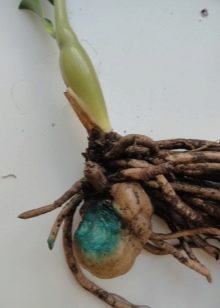
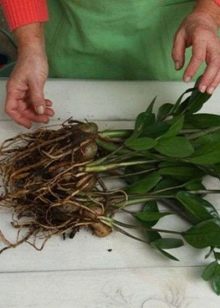

If a planned flower transplant is performed, then it is worth using the transshipment method, while acting carefully and carefullyO. There is no need to shake off the soil from the root system, as if it is damaged, the plant will most likely die. It is necessary to transfer the plant with a clod of earth to the center of a new pot, which is already a little filled with sand and soil mixture, and then sprinkle all the roots of the tree with the remaining soil. The roots should look out a little from the ground.
As mentioned earlier, after transplanting, you should refrain from watering. If the ground is very dry, then after a few days you can start watering. If the soil was wet during planting, then it is better to water it after about 2 weeks. It is with the help of the first watering after transplanting that all the voids in the pot are filled. If there is not enough land, then it can be added to the container with a flower.
After transplanting, the plant already produces stronger and larger leaves. Sometimes, under their own weight, they begin to disintegrate in different directions, so you should immediately install the ring support.
If you need to make a planned transplant, then it is better to do this in March or April, but in the cold season it is better to refuse this procedure.
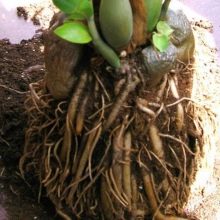
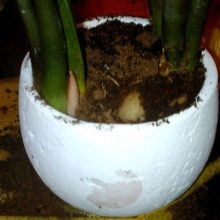
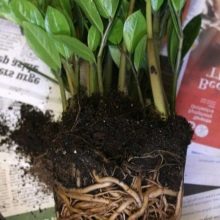
Diseases and pests
Zamioculcas is a fairly strong, hardy and unpretentious plant that rarely gets sick. But if you do not adhere to the rules of care, then the tree will quickly dry out. It is worth considering the most common diseases.
Rotting roots
The reasons may be low temperatures, frequent watering, the use of hard and unstable water, moisture retention on the sump, and others. The leaves of the plant turn black, shriveled into the stems. With an excess of moisture, it is worth immediately transplanting the plant into a new soil. All rotten roots should be removed, and healthy ones should be washed in potassium permanganate or in a solution of any fungicide, which copes well with rot, and dried before planting. All cuts and cuts should be processed with crushed coal.


Yellowing of leaves
If yellow leaves start to fall off, don't be discouraged, as this is a natural process. Thus, the plant renews the leaves. New green leaves will grow in their place. When the leaves are completely dry, they must be carefully torn off. But if new leaves do not appear, then perhaps the plant needs more frequent watering or feeding, it is located in a draft, or a temperature difference often occurs in the room.
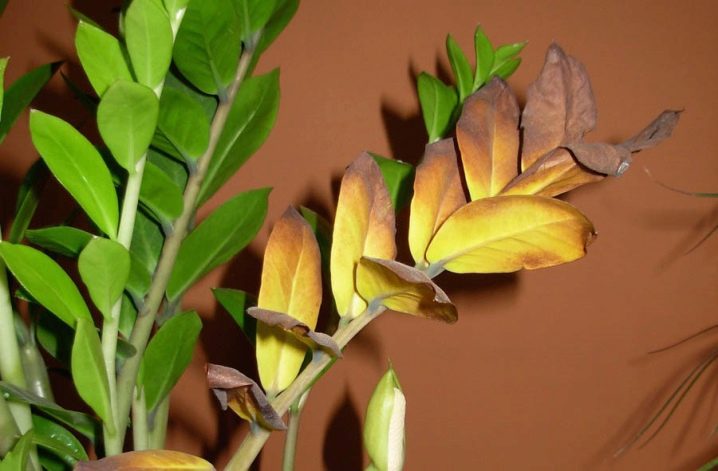
If you do not carry out the necessary care, then the zamioculcas begins to suffer from various pests, for example, spider mites, scale insects or aphids. It is worth considering the pests of the "dollar tree" in more detail.
Aphid
This insect can be black, green or gray in color. It sucks the sap from the plant on the back of the leaf. It multiplies very quickly, as a result, the leaves of the zamiokulkas begin to turn yellow, dry up and fall off. Suitable for treatment are drugs such as Fitoverm, Aktellik, Aktara, which contain instructions for use.
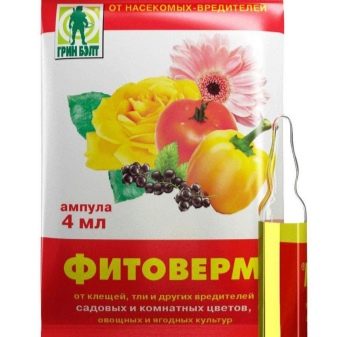
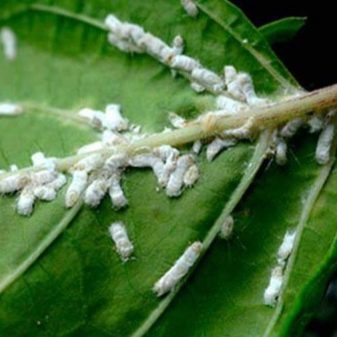
Spider mite
This is a red spider, which is located on the back of the leaf. It is impossible to see it, but you can immediately see a white cobweb in the places where it lives. To begin with, you should thoroughly rinse all the leaves under a warm shower, while paying special attention to the back side. This way you can get rid of most of the insects. And in order to eliminate all the larvae and eggs of the tick, it is necessary to use insecticides.
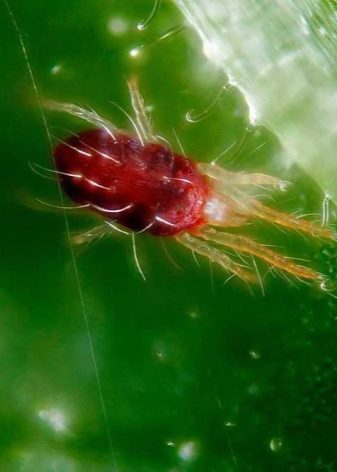
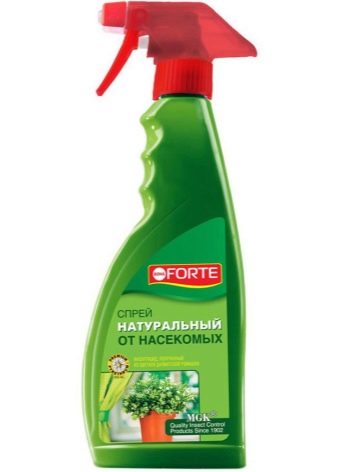
Shield
This insect grows and reproduces rather quickly. The leaves of the plant begin to become covered with dark spots. If the adults are in one place, then the larvae are actively spreading throughout the plant. To remove adult scale insects, a wet swab is sufficient. You will need to use a soapy solution to remove the larvae. Although only the use of chemicals gives a 100% guarantee. For the best result, the plant should be covered with a plastic bag, and after a day it should be removed, and the leaves should be rinsed under a warm shower, while preventing harmful effluents from entering the plant soil.
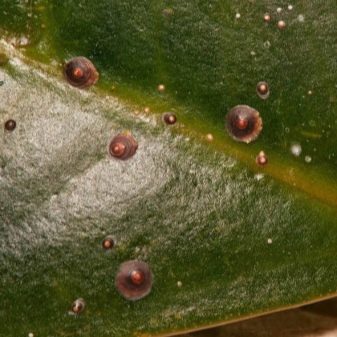
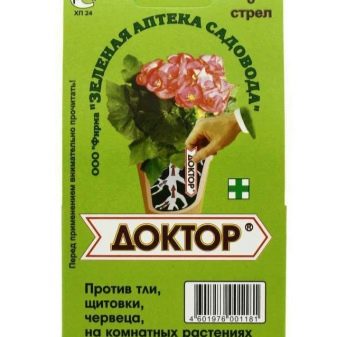
If the zamioculcas is practically destroyed from above, you should pay attention to its root system. If the roots are healthy and elastic, then they should be disinfected with a solution of potassium permanganate, dried thoroughly and transplanted into new soil. Place the pot in a well-lit place and provide moderate watering.
Under these conditions, the plant can again form the ground part.
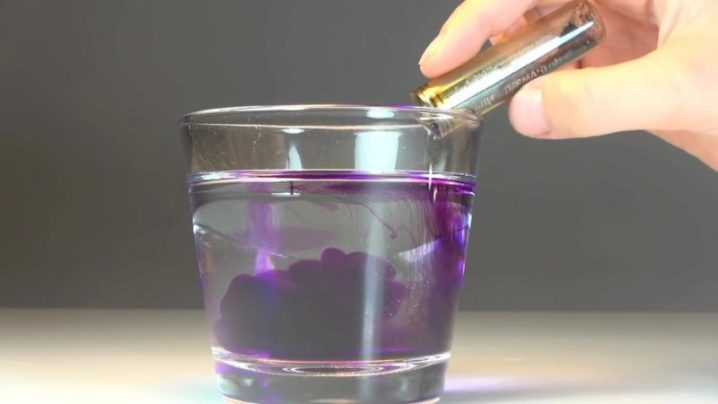
Reproduction
The "dollar tree" can be propagated in several ways, any part of the plant is suitable for this. It is best to reproduce in the spring, as rooting is much faster than during other periods. It is worth paying attention to the possible vegetative reproduction methods.
Feather-leaf
To use this propagation method, you can use any leaf of the plant - it can be accidentally or deliberately torn off. An incision must be made in the petiole at a 45 degree angle. Then the petiole should dry thoroughly (2 days), better, of course, in the open air. So, the breeding process is as follows:
- it is necessary to take a small pot and pour soil into it, consisting of river sand (coarse) and peat;
- all sections should be treated with activated carbon;
- so that the roots are better formed, it is worth using phytohormones, such as "Zircon", "Kornevin";
- the leaf should be deepened into the ground by 1/3;
- cover the top of the pot with a film or a jar to create a greenhouse microclimate;
- regularly you need to slightly moisten the soil, as well as wipe the condensate and ventilate;
- it is worth adhering to +22 degrees Celsius;
- after 2-3 months, the old leaves will begin to dry out, but new ones will form in their place (after six months);
- then each leaf will need to be transplanted into a separate container.
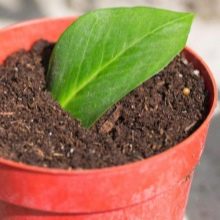
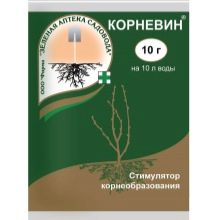
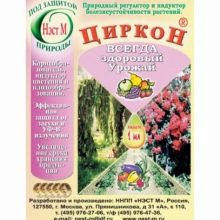
A simpler method is worth considering. It is necessary to break off one leaf and put it in a container with water. When roots appear on the root, it can be planted in the soil. But it is worth doing infrequent watering to prevent the formation of rotting of the root system. This breeding method has both pros and cons. The advantages include the fact that in just 1 year there will already be a large plant from the leaf.
Unfortunately, only 2 leaves can be cut from zamiokulkas in order to preserve its attractive appearance, so it will be possible to create only 2 new plants.

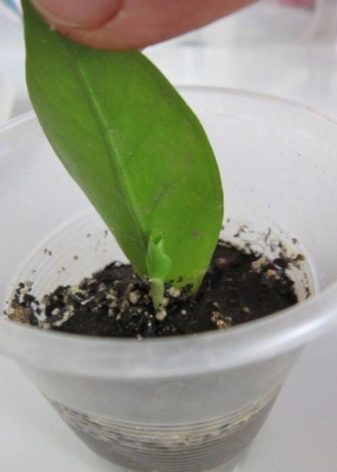
Compound sheet
This option is only suitable for viable seedlings. Daughter tubers should form on the tree so that this method of propagation can be started. The process looks like this:
- it is worth separating a complex leaf with a dot-tuber from the mother;
- with the help of activated carbon, you need to process all the roots, give time to dry;
- prepare a pot with a substrate, as for an adult plant, and plant a seedling in it;
- the leaf should remain on top, and the tuber - in the ground;
- it is worth waiting a few days with watering;
- continue caring for the plant according to the usual schedule.
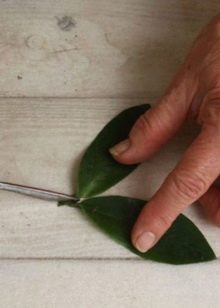
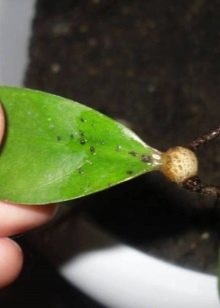
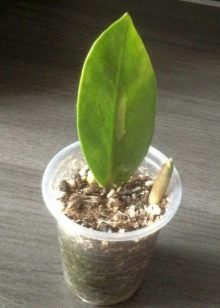
Division into parts
This method is considered the simplest, but rather risky. It will require using a fully grown plant, and if something goes wrong, you can completely lose the plant. The process itself looks like this:
- get the plant out of the pot, divide the rhizome into parts, with a growing point in each part;
- each part should be treated with activated carbon;
- allow to dry in the fresh air throughout the day;
- plant each tuber in a separate pot;
- the tuber head should be slightly above the ground;
- plants should be provided with normal watering, but fertilizing should be abandoned for now;
- new trees will take a long time to grow, so be patient.
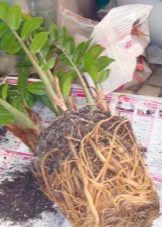
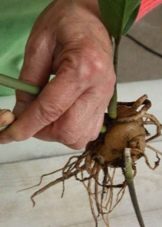

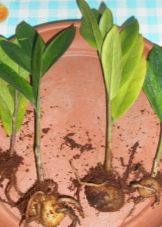
For information on how to grow zamioculcas, see the next video.























































The comment was sent successfully.